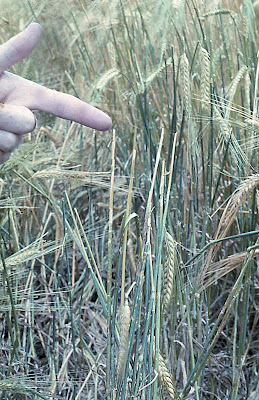White heads and stem borer in wheat
Every year we receive reports of white heads in wheat, and while there are several possible causes of this symptom, one suspect implicated in the crime is a small stem boring larva called Ephysteris silignitis (Turner) belonging to the moth Family Gelechiidae.
Rod Collins and Hugh Brier did some investigative work back in 1998. They reared a couple of larvae through to the adult moths and had them identified by ANIC.
Rod Collins made the following observations: “The damage was usually confined to a single tiller per plant at a relatively low incidence through fields. Infected tillers seemed to have flowered normally, but soon after flowering the stem upwards from the last node (and including the head) died and was white in colour with no grain in the head. From a distance, these symptoms appeared to be the same as those of crown rot. However, infected tillers were green and apparently healthy from the last node (including the flag leaf) down. On closer examination, a small entry hole about the size of a pinhead was evident usually at or just below the first node up from the base of the plant. In some cases an exit hole was noted just above the last node.”
“When the stem was split open, you could follow where the larva had been up until the last node, where it was often found feeding on the tip of the stem just above the last node. In some cases, the larva had chewed through the tip and continued to move upwards towards the head. It appeared that once the stem began to dry out, the larva would bore a hole in the stem and exit. Only one larva was found per stem in all the plants that I saw.”
It seems not much is known about this species. It is believed to be a native species, one of three in this genus found in Australia. Ephysteris promptella is recorded as a pest of sugarcane in Australia. Ephysteris silignitis occurs widely in Australia south to about 35 degrees south and is thought to be confined to Australia. It is in the wettest parts e.g. Brisbane and Mt Bellenden Ker and the driest. It is common at Alice Springs. It was suggested that it may feed on grasses but there was no evidence.
 Stem borer larva in wheat (Photo by Iain Macpherson)
Stem borer larva in wheat (Photo by Iain Macpherson)At this stage the reports of isolated ‘white heads’ do not represent economic loss, but this stem borer is something to be aware of if those scattered white heads are observed in fields. There is no registered chemical control.
Labels: stem borer, Winter cereals


